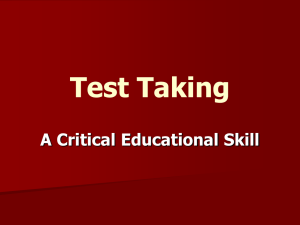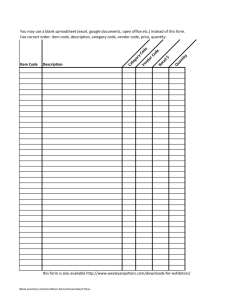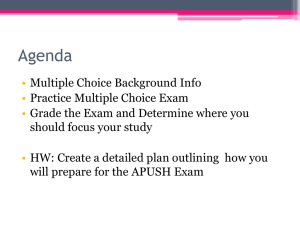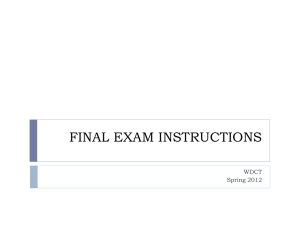TEST TAKING STRATEGIES
advertisement
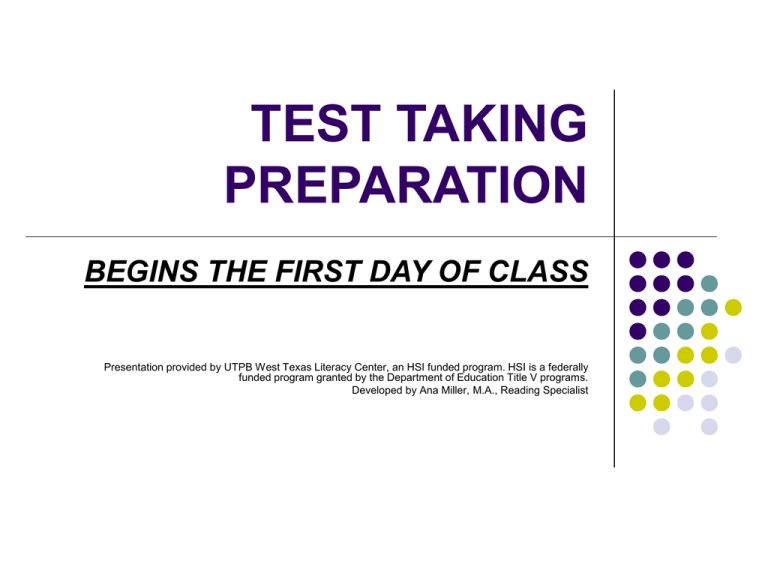
TEST TAKING PREPARATION BEGINS THE FIRST DAY OF CLASS Presentation provided by UTPB West Texas Literacy Center, an HSI funded program. HSI is a federally funded program granted by the Department of Education Title V programs. Developed by Ana Miller, M.A., Reading Specialist Test Anxiety: How Do We Develop Feelings of Panic? Past experiences Inadequate preparation Why prepare? Less anxiety No time constraints Access to books notes, and tutors Answers are in your book, handouts, notes, other resources Preparedness = Improved performance Test Preparedness Analyze the professor’s test technique Complete projects and papers well before scheduled exams Create study guides and flash cards as you take notes Adjust your study method. For objective tests, focus on specific details. For essay exams, focus on broad concepts and relationships. Types of Tests Open book Computation Essay Short answer Fill in the blank True-false (objective) Multiple choice (objective) Open Book Tests Prepare Become extremely familiar with the book, handouts, study guides If you are allowed, make a reference sheet to save time Focus on main ideas and where you can find them in the book or other approved materials Highlight important points, use post-it-notes, add notes IF ALLOWED Open Book Tests Continued Take all resources the professor has approved Answer the questions you know, then go to your resources Use your book and other resources as a back up and for verification Computation Tests Understand why, when, and how to use specific formulas Create a formula study sheet and use it as a review When you receive the test, write down the formulas you can remember in the margin of the test READ ALL DIRECTIONS CAREFULLY Show ALL work (partial credit) Check over the test Essay Exams Read the directions carefully Read and analyze the questions critically Be sure that you understand the question. Do a “Memory Dump” –Quickly write out memorized dates, names or points, so you can relax, think, and write Create a quick outline or other organizational format Begin with a thesis sentence and refer to your major points Focus on one main point per paragraph Use the technical vocabulary and define the terms Proofread Watch the time BE NEAT Understand the Question COMPARE = Examine qualities of what is being compared, stress similarities CONTRAST = Examine qualities of what is being contrasted, stress differences CRITIQUE = Evaluate merits and faults DEFINE = Brief, clear meaning DESCRIBE = Objectively tell about something, do not evaluate it DIAGRAM = Create an appropriate, labeled chart, plan, or drawing DISCUSS = Make a detailed analysis (study), including description and/or comparison, contrast, or evaluation Understand the Question ENUMERATE = List and briefly discuss the required points EVALUATE = State your opinion, supported by examples; give advantages and disadvantages EXPLAIN = Clarify and interpret, stating “how” and “why,” including expert opinion if appropriate ILLUSTRATE = Literally draw a graph or create a clear example INTERPRET = Translate, give examples, solve, or discuss; include your judgment or feelings JUSTIFY = Give evidence to support your conclusions Understand the Question LIST= List and briefly discuss required points OUTLINE = Give an organized description, focusing on major points and supporting details PROVE = Confirm or verify; use logical reasoning to make your points, or state evidence and evaluate it REVIEW = Critically and systematically examine, analyzing each major point STATE = Briefly express main points SUMMARIZE = Write a condensed discussion of main points or facts TRACE = Describe a series of events in chronological or other appropriate order Objective Tests Answer the easiest questions first Read all of each question and the choices carefully before selecting an answer When you must guess, eliminate first For true/false questions, assume that a statement is true until you prove otherwise Always write something on fill-in-the-blank questions Think about the question Objective Tests Continued Should you guess? YES, but consider this: Use of absolute words (all, none, always never) Often untrue Use of moderate qualifiers (often, frequently, many…) more likely to be true Look for clues within the question itself Longer, more detailed answers tend to be correct. If two answers are total opposites, one is likely to be correct If two answers are very similar, it is likely that both are incorrect Fill-In-The-Blank Tests Remember basic rules: Unless directions say otherwise, one word per blank The length of the blank is not necessarily a clue to the length of the word The completed sentence should make sense and be grammatically correct Blanks separated by commas, indicate a series of items Several blank lines without commas indicate a phrase with a specific number of words. The word “an” before a blank indicates that the needed word begins with a vowel sound. Fill-In-The-Blank Tests Answer the questions you know, bypass the difficult ones Return to the difficult questions; using delayed response Those questions remaining, apply assisted response, skim through the items that will trigger an association to the needed word Finally, WRITE SOMETHING If time permits, review REVIEW Review- Look for skipped items, answers marked in the wrong space, or illegible answers SHOULD YOU CHANGE ANSWERS? Know your own history Do you tend to find wrong answers and correct them? Then continue to do so. Do you tend to second guess yourself and change right answers to wrong ones? Then be cautious. Change only if you realize that you misread or misunderstood the question on the first attempt or if you recall a relevant fact that warrants changing an answer Oral Tests Confirm time and place Take visual aids and props Dress appropriately Be early Turn off cell phone Maintain eye contact Maintain correct posture Speak clearly and with proper formal grammar and diction Speak in complete sentences Thank the instructor Test Taking Tips Worth Repeating!!! PREPARE, PREPARE, PREPARE-START EARLY!!! Arrive early and prepared Read ALL the directions carefully Preview the exam before you begin Plan your time Read all of the question and choices completely and carefully Answer the easiest questions first Answer every question, even if you have to guess (unless there is a guessing penalty-ask the professor) Review if time permits Post Test Relax and celebrate Carefully analyze the errors when the test is graded and returned Ask the professor for clarification if you do not understand why you lost points Disappointed by Your Grade? Seek the professor’s advice with the attitude that you want to improve next time. Remember test taking is a skill that requires TIME AND EFFORT to develop. You may want to seek assistance: Literacy Center- Ana Miller MB 4180 Math & Science Center- Jill Miller MB 4180 Writing Center- Kellye Manning MB 2100 Mentor program- Stephanie Hernandez MB 4109 SI (Supplemental Instruction) Dr. Castro Pass Office References Feldman, Shattles, & McKenzie. (2004).Oracle EDU 1110. Unpublished manuscript, Southern Methodist University, Dallas, TX
